Farewell, Tech Trolley. Hello, New Transit.
Goodbye to an Icon
One of Georgia Tech’s most beloved symbols has been missing this year – the Tech Trolley. Parking and Transportation Services (PTS) made the tough decision to remove the Tech Trolley from campus bus routes to help with social distancing on campus transit. Due to Covid-19, campus buses are providing 50 percent of their normal occupancy to maintain distance between passengers. Stinger buses seat 45 passengers while the Trolley seats only 35. PTS decided to replace the Trolleys with Stinger vehicles to provide the most seating possible. The current Trolley fleet has been in service 10 years and was costly to repair and maintain.
“Prior to the pandemic, we had planned to phase out the Trolleys over the course of this academic year and replace them with additional Stinger buses,” said Aaron Fowler, Director of Transportation. “The Trolleys were purchased by our transit vendor in 2010 and have fully met their useful life. As campus began planning for re-opening with in-person instruction last fall, we knew that the bench-style seating in the Trolleys would not be optimal for encouraging social distancing. The pandemic forced us to move up our Trolley retirement timetable without a lot of fanfare, but we knew it was the right decision for everyone’s safety.”
The Tech Trolley was introduced to campus in August 2003. Its route was created to connect main campus to MARTA and the newly opened Technology Square. A new fleet of Trolleys graced the campus in 2010, carrying more than 10 million passengers in 10 years. It was the first university transit system in the state to utilize real-time GPS bus tracking through the Nextbus system in 2005
The Trolley was known for its bright yellow color, tinkling bell, and wooden bench seating, which made it a popular choice for special events. With an average of 50 bookings per year, the Trolley has been a part of the Atlanta Pride Parade, Invest Atlanta House tours, Alumni Association Homecoming campus tours, new employee orientation and Georgia Tech Advisory board meetings. Trolleys have also been a favorite for wedding ceremonies, transporting brides, grooms, and their wedding parties, and serving as backdrops during photoshoots.
Serina and Simon Awadalla used the Tech Trolley in their November 2019 wedding. “Most of our bridal party are GT alums,” said Simon (ME 2009). “We all have Yellow Jacket pride, so we sang the fight song the entire time we were onboard.”
Tech alumnus Steve Martin (BS, Chemistry, 1969) chartered the Trolley to transport guests for his 50th wedding anniversary with wife Loni. Steve, whose family boasts four consecutive generations of Tech alums, chose the Trolley because it brought a special touch to their celebration. “When planning, we instantly thought of the Trolley,” said his daughter-in-law Susan Martin (BTE 1994). “It was a lot of fun and memorable for the whole family.”
What began as an innovative way to connect campus to metro Atlanta quickly became an iconic symbol of Georgia Tech. “The Tech Trolley was originally chosen as a way to bring attention and excitement to a new bus route traveling to a completely new part of campus,” Fowler said. “The Trolley route was very effective in building ridership. Nearly half of all our campus ridership is now on the Gold Route, which is the former Tech Trolley route.”
The Tech Trolley holds many special memories for students, employees, visitors and alumni. If you have special memories of the Tech Trolley, share them at support@pts.gatech.edu.
Preparing for a New Fleet and Self-Operation
Once the current transit contract expires, Georgia Tech will be moving to a self-operated transit service for July 2022. The self-operated program will allow Tech to purchase a more sustainable bus fleet, including hybrid electric buses and adding more buses to the highly used Gold Route during peak hours. The move also will allow drivers to be Institute employed and open the door for funding outside of student fees.
Senior director Sherry Davidson said moving to self-operation improves sustainability while maintaining fiscal responsibility. “Transportation took a hard look at how we could build the future that we all wanted to see. The result was changing the way in which we operate.
“Over the past two years we have had a series of conversations with the Student Government Association, sustainability groups, and the Mandatory Student Fee Advisory Committee on what the future of campus transit could look like,” Fowler said.
New buses will be ordered this spring, with new technologies and services being procured over the next 18 months. Onboarding for approximately 50 employees will take place before the new fleet begins operation in July 2022.
As the current transit contract with Groome Transportation approached expiration in 2021, PTS released an RFP in 2019 for new campus transit services. “The results were not as sustainable as everyone had hoped,” Fowler said. “As we took a step back to reevaluate our priorities, our leadership team made the case that campus could move to a more sustainable bus fleet and receive a higher level of service for an overall lower cost if we transitioned to self-operation.”
Since 2018, PTS has worked with students and employees to garner feedback about future transit services and self-operation. The campus community noted five focus areas: sustainable fleet, more reliable service, less overcrowding, increased accessibility, and improved technologies.
PTS is hopeful that it can meet these focus areas with self-operation, including implementing at least 30 percent of the new fleet as hybrid-electric buses. Hybrid buses generate power as they are on route, which reduces overall oil consumption and carbon footprint. “Over time we anticipate the entire fleet being transitioned to hybrid-electric,” said Fowler.
Davidson noted the move to self-operation is expected to result in significant cost savings and reduce the impact to student fees. “We expect to have more funding sources, which has the potential to further increase the level of service at a lower cost per service hour.”
Next steps include completing funding and incorporating stakeholder input. “During stakeholder meetings, the community spoke clearly about the need to move toward a more sustainable model for our transportation system, as well as the need for improved service reliability, capacity, technology and cost containment,” Davidson said. “We have relied upon that feedback as we’ve finalized the details of our future program.”
To track the status of the new fleet’s implementation, bookmark Tech Transit: 50 Years and the Future.
Related Media
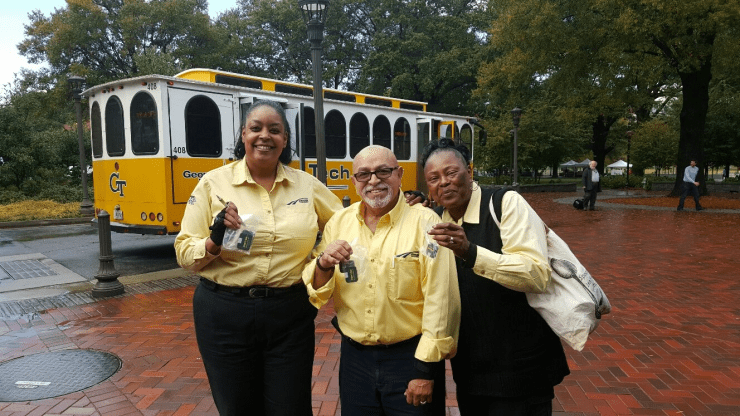
ALL SMILES: Tech Transit drivers love being a part of the Yellow Jacket community.
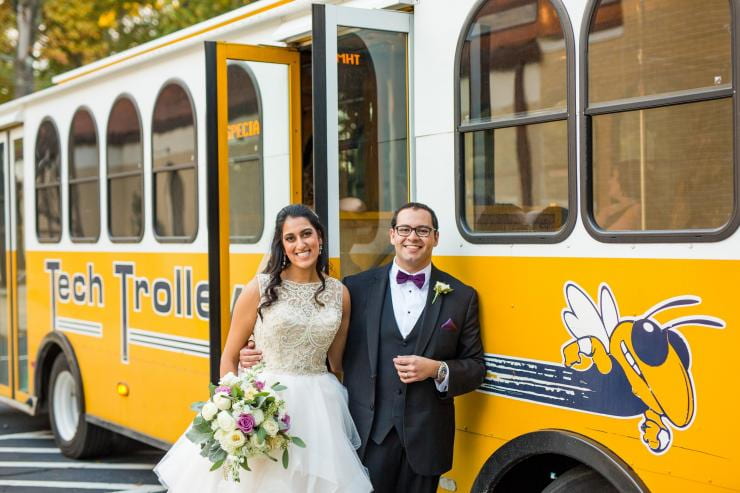
WEDDING BELLS: Simon and Serina Awadalla used the Tech Trolley in their November 2019 wedding. “Most of our bridal party are GT alums,” said Simon (ME 2009). “We all have Yellow Jacket pride, so we sang the fight song the entire time we were onboard.”
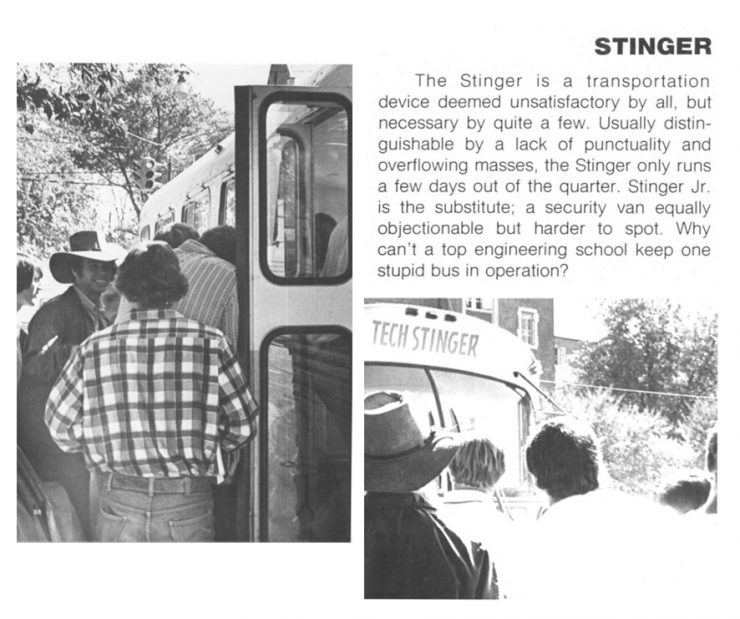
CRITICS CHOICE: In its early days, Tech Transit was not without criticism. The Technique published this statement in 1973 highlighting mixed reviews of the Stinger bus and the newly implemented Stinger Jr.
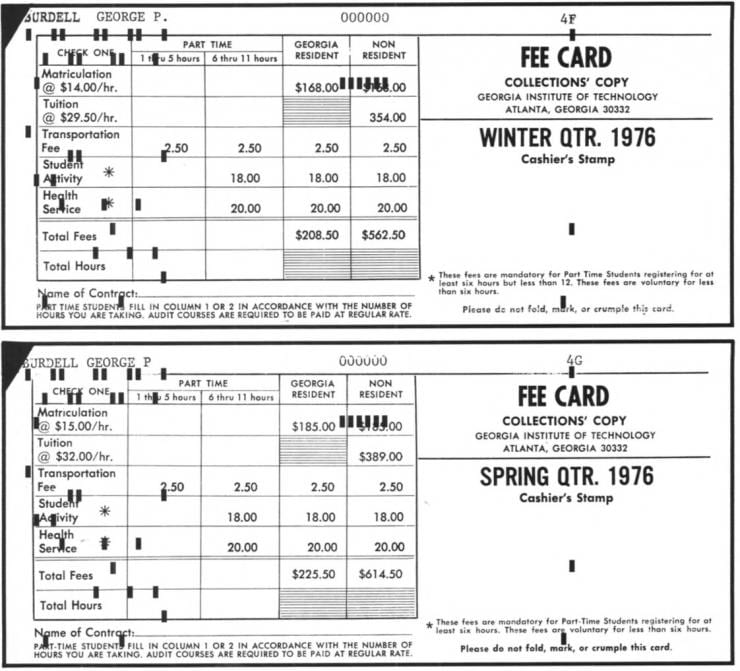
PAY YOUR WAY: Student paid quarterly fees in 1976, with only $2.50 for transportation.

FULL OF FLARE: Like the fashion of 1975, Tech Transit took on its own flair with Tech gold and white design.
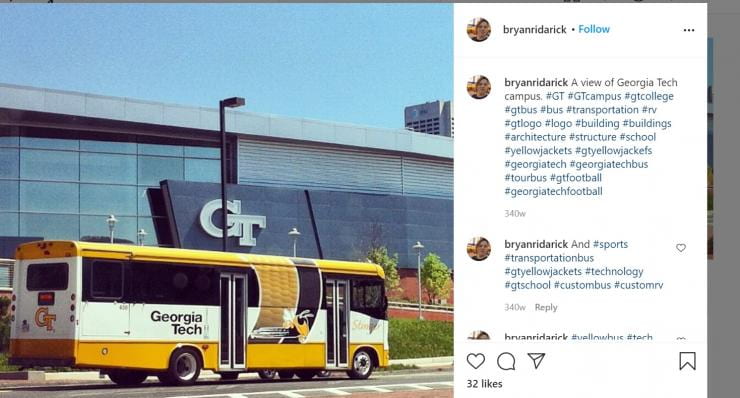
PICTURE PERFECT: The Stinger bus sails past McCamish Pavilion on its way to the main campus.
